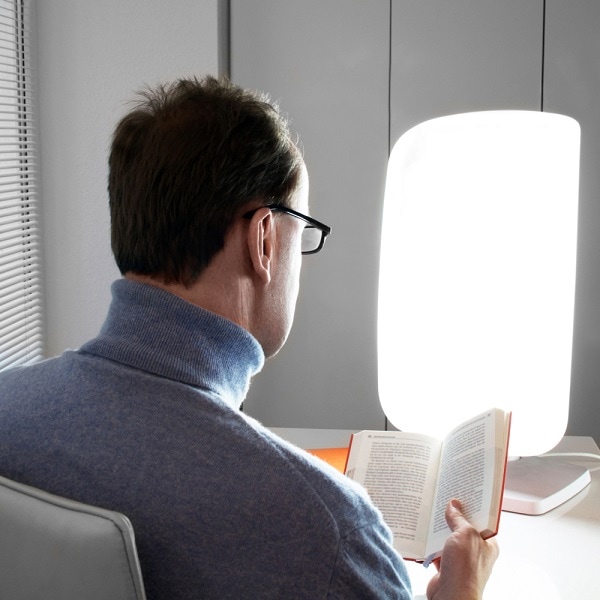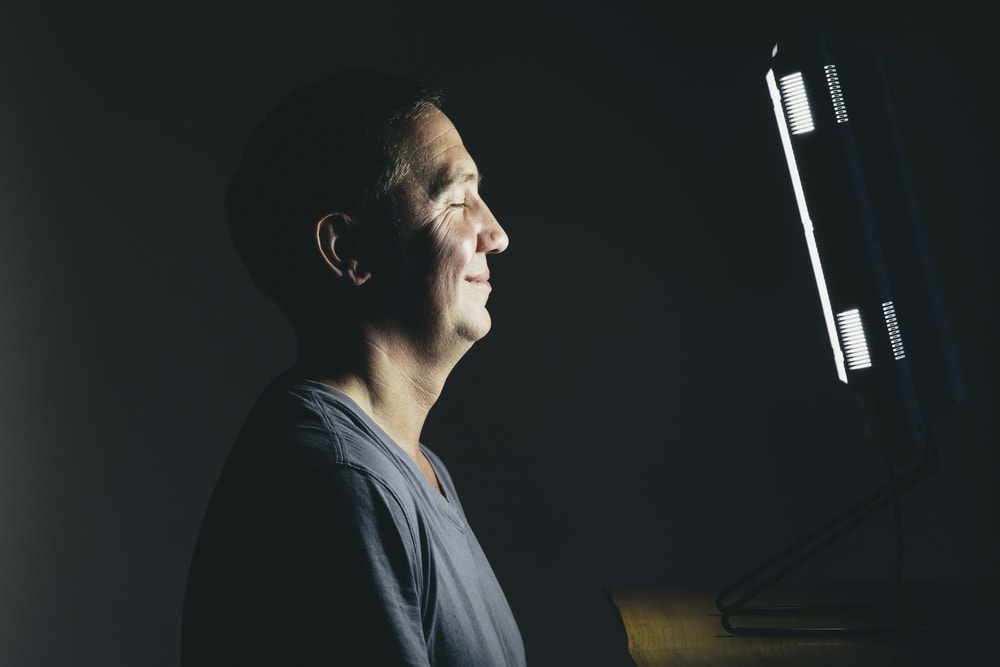What is it about opening the curtains on a sunny day or seeing the shift from dark winter months to bright sunny days that just lift your mood and change your outlook? Light seems to hold power over us to help us feel better, but is there any science behind light and its ability to heal?
What Is Light Therapy?
Light is a tiny segment of the natural electromagnetic spectrum of radiant waves from sources as diverse as AM radio stations and x-ray machines. The segment of waves we can see with our own eyes is arbitrarily called “light.”
Light ranges in wavelength from red to blue. The light we see in a rainbow follows this spectrum of light. Light has been used for centuries as therapy; however, most of the time, this meant getting to “get some sun.” Nowadays, light from all parts of the spectrum is used for a variety of reasons.
What Are the Benefits of Light Therapy?
As you’ll see, light from the red end of the light spectrum carries different qualities than light we see as blue. Outside of the light we see, we can see therapeutic benefits just above blue or below red on the spectrum. These are called ultraviolet UV) or infrared (IR) electromagnetic waves, respectively.
When we talk about the benefits, be aware that the color of light matters in its effects on the human body.
Reducing Stress and Anxiety
Stress and anxiety can be improved with full-spectrum light, which mimics the effects of the light we get from the sun. When the sun is brightest, natural light exposure during the daytime hours allows your eyes to know it’s daylight, even when you’re stuck in a windowless office.
If you properly time your light exposure to these daylight hours and turn it off in the afternoon, you relax and sleep better at night. Over several days, this regular pattern of daytime light exposure and improved sleep can reduce your anxiety and build resilience.
Improving Mood and Sleep Quality
Full-spectrum light also enhances mood, also by improving sleep. Our circadian rhythm, which sets alertness and sleep to the 24-hour clock, is determined by a tiny cluster of cells in the hypothalamus called the suprachiasmatic nucleus (SCN). The SCN is modulated by the light your eyes see during the day. This same cluster of cells tells the pineal gland when to make melatonin.
Melatonin is the hormone you rely on to regulate sleep. It doesn’t knock you out at night but prepares the body for slumber so that sleep comes on naturally. During the winter months, the sun has less power to regulate the circadian rhythm in those who live at latitudes further from the equator.
Full-spectrum lights can be used in the home or workplace to help everyone feel less fatigued during the darker months.
People with seasonal affective disorder (SAD) are more sensitive to the variations in sun exposure between summer and winter. Full-spectrum lights can help avoid the use of antidepressants in individuals with SAD symptoms or other mood disorders like the winter blues.
Relieving Pain and Inflammation
For relief of pain and inflammation, light on the red end of the spectrum is used. Doctors can use low-level light therapy (LLLT) involving light from any part of the spectrum to relieve pain and inflammation when applied to the skin. The low-level light is weak enough that the light and not heat itself exerts the effects beneath the skin.
Infrared light is not visible light but is often felt as heat. The heat can act on nerves and other tissues to promote healing by enhancing circulation in the affected areas. This is used to manage muscle pain or injury and promote rapid tissue healing.
Immune Effects
Light from ultraviolet light sources has been used to reduce inflammation in disorders like vitiligo, psoriasis, and cutaneous T-cell lymphoma. Sometimes, UV light will stimulate the immune system to fight the disorder. In others, like atopic dermatitis, UV light may reduce the effects of an overactive immune system on this disease.
Enhancing Cognitive Performance
The advantage of light therapy on cognition or thinking is seen most in full-spectrum light, which enhances sensations of alertness and focus.
How Does Light Therapy Work?
Light therapy works through several mechanisms. When it is used by your eyes in actually “seeing” the light, it affects the hypothalamus and enhances the function of the circadian rhythm. Light used on the skin can enhance circulation, improve new blood vessel formation, and stimulate or tone down inflammatory cells, depending on the circumstances.
What Types of Light Therapy Are Available?
Let’s review the types of light therapy again and see how they are used in clinical settings.
Bright Light Therapy
Bright light therapy is also called full-spectrum light. It appears white and has the full range of light you’d see in the sunshine. When you purchase a light like this for your desktop and look periodically at it during the day, you will get an increase in mood and better sleep through its effects on the hypothalamus.
Red and Near-Infrared Light Therapy
This light treatment is warmer and appears to have better benefits in pain reduction and decreasing inflammation. Apart from their heat, these lower light wavelengths can heal tissues that lie a short distance beneath the skin.
Blue Light Therapy
Blue light and UV light, which is shorter than the blue wavelength, are used for skin conditions and diseases. Blue light is being used to treat sun-damaged skin that has not yet become skin cancer. Acne is sometimes treated with blue light, while blue light frequencies are stimulating to look at. For this reason, blue light treatment alone can be used to treat low mood disorders like depression.
What Are the Risks of Light Therapy?
Light therapy is best begun under expert guidance. Light of any wavelength exposed to the eyes at too great a light intensity can cause cataracts or other vision loss problems. Blue light used at the wrong times of the day can keep you awake at night. Red light is warm enough to burn the skin if used at high intensities for too long.
How to Get Started With Light Therapy

Light therapy is used at doctor’s offices, spas, and as home devices. Psychologists and dermatologists can recommend light therapy for very different reasons.
Consult a Healthcare Professional
Before deciding to use any type of phototherapy device, see a healthcare professional who treats these disorders. If you are depressed, for example, see a doctor or psychologist before deciding that light therapy is the right treatment for you. You can use a home device once you’ve seen the provider. Some phototherapy devices are only available at the provider’s office.
Choose the Right Device
Remember that the light wavelength says a lot about the anticipated effects. Once you choose the wavelength, make sure you have a device with clear instructions and one that provides you with the ability to adjust the light intensity and timing.
Follow Directions Carefully
Many light therapy devices have specific intensities, wavelengths, and durations you should use for optimal effects. Most experts are quick to point out that more is not better when it comes to phototherapy treatments.
Conclusion
Light therapy or phototherapy can be very powerful in helping you heal from various health issues. However, be aware of the risks and benefits before you proceed with any treatment on your own.
FAQs:
Q1: What is light therapy used for?
Light therapy is used for a variety of conditions ranging from mood disorders, poor sleep, and anxiety to disorders of the skin and soft tissue, where it promotes healing, reduces pain, and protects against sun damage.
Q2: Is light therapy safe?
Light therapy is generally safe as long as you protect your eyes from overexposure. Your skin can also be overexposed to heat or to light wavelengths that damage your skin or cause burns.
Q3: How long does light therapy take to work?
Red light therapy may relieve pain quickly but will take longer to heal inflamed areas. Full-spectrum light can quickly boost mood in a few days, but extended use is needed to resolve seasonal depression more effectively.
References:
- Barros, N. M., Sbroglio, L. L., Buffara, M. O., Baka, J. L. C. E. S., Pessoa, A. S., & Azulay-Abulafia, L. (2021). Phototherapy. Anais brasileiros de dermatologia, 96(4), 397–407. https://doi.org/10.1016/j.abd.2021.03.001.
- Campbell, P. D., Miller, A. M., & Woesner, M. E. (2017). Bright Light Therapy: Seasonal Affective Disorder and Beyond. The Einstein journal of biology and medicine : EJBM, 32, E13–E25. https://www.ncbi.nlm.nih.gov/pmc/articles/PMC6746555/.
- Tsai, S. R., & Hamblin, M. R. (2017). Biological effects and medical applications of infrared radiation. Journal of photochemistry and photobiology. B, Biology, 170, 197–207. https://doi.org/10.1016/j.jphotobiol.2017.04.014.

